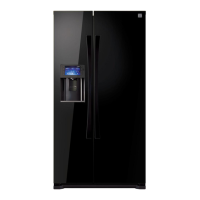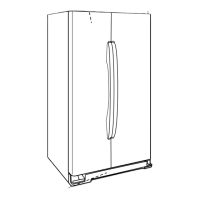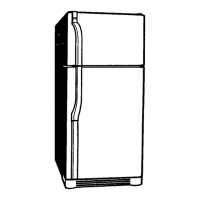Do you have a question about the Kenmore 41003 and is the answer not in the manual?
Details the limited warranty coverage for Kenmore Elite refrigerators, specifying terms and conditions for repairs and failures.
Outlines limitations on implied warranties and remedies for consequential damages, subject to state laws.
Explains the benefits and coverage of Master Protection Agreements, including expert service and guarantees.
Provides contact information for professional installation services for various home appliances by Sears.
Section to record purchase date, model, and serial number for future reference and service needs.
Outlines general safety messages, hazard symbols, and meanings of signal words like DANGER, WARNING, and CAUTION.
Addresses the danger of child entrapment in old refrigerators and provides instructions for safe disposal.
Provides critical warnings about electrical hazards, fire risks, and safe usage practices for the refrigerator.
Details warnings regarding electrical hazards, flammable substances, proper grounding, and avoiding damage to the cord.
Advises on safe practices like avoiding loose plugs, not storing items on top, and handling cold surfaces to prevent injury.
Covers cautions for long vacations, service modifications, supervision of children, and avoiding blocked air holes.
Explains the importance of proper disposal of CFC refrigerants due to environmental regulations and potential penalties.
Details mandatory grounding procedures for electrical safety, including outlet types and the prohibition of extension cords.
Identifies and describes various parts and features of the refrigerator and freezer compartments with page references.
Provides notes on potential door handle loosening and the effect of closing one door on the other.
Guides on selecting the best location and ensuring sufficient space for proper refrigerator operation and door opening.
Specifies required clearances around the refrigerator for optimal cooling, power consumption, and preventing overheating.
Details the need for a level, strong, hard surface for installation and how to protect flooring during movement.
Instructions for safely removing tape, labels, and preparing the refrigerator for use, including shelf placement.
Lists essential parts included with the refrigerator for installation, such as water filters and wrenches.
Identifies the necessary tools for installing and adjusting the refrigerator, including screwdrivers and wrenches.
Step-by-step guide to safely remove the freezer door, including disconnecting wires and hinges.
Detailed instructions for removing the refrigerator door, covering ground wires, hinges, and hinge brackets.
Specifies required water pressure for the icemaker and mentions the role of the water filter for water purification.
Provides instructions on shutting off water, locating the line, and using pipe clamps and shut-off valves for connection.
Lists necessary components like compression nuts, tubing, and ferrules for connecting the water supply line.
Step-by-step guide for installing the water filter, including removing covers, aligning the filter, and setting replacement indicators.
Instructions to flush the water dispenser after filter installation to remove contaminants and air, ensuring proper operation.
Guide on testing the icemaker's water fill function and what to do if the water level is too low.
Guides on moving the refrigerator into its final location, ensuring clearance requirements are met.
Detailed steps on how to use the front leveling legs to ensure the refrigerator is stable and doors close properly.
Provides instructions on using an Allen wrench to adjust hinge bolts for precise alignment of refrigerator and freezer doors.
Describes the Graphic User Interface (GUI) of the digital panel, its functions, and touch button operations.
Instructions on how to adjust the internal clock and date displayed on the refrigerator's digital panel.
Guide on adjusting the touch screen sensitivity and accuracy for optimal user interaction.
Explains how to navigate and use the main 'Home' screen to access various refrigerator functions.
Instructions on how to activate and use the slide show feature, potentially displaying saved photos.
Details on how to engage and disengage the child lock function to prevent unintended operation of controls.
Explains how the dispenser lighting operates automatically and how to use the accent lighting feature.
Instructions on how to turn the icemaker on/off and select between cubed and crushed ice types.
Guide on how to select and dispense refrigerated water from the dispenser.
Explains the 'Cooling Off' mode, used for showrooms, which disables cooling but keeps power on.
Describes the function and operation of the audible alarm that sounds when the refrigerator door is left open.
Step-by-step instructions for creating and saving memos in the refrigerator's calendar for daily scheduling.
Guide on how to set alarm times for calendar memos to receive timely reminders.
Instructions for marking special dates like birthdays or anniversaries in the calendar.
Information on setting recurring reminders for memos or special days on a daily, weekly, monthly, or yearly basis.
Steps to edit or update existing calendar memos, including setting alarm times.
Instructions for modifying previously entered special days, including their associated details.
Procedure for removing specific memos from the calendar, including confirmation steps.
Instructions on how to remove special day entries from the refrigerator's calendar.
Explains how the calendar alarm sounds and displays a notification for upcoming memos or special events.
Guide on adjusting the temperature settings for both the refrigerator and freezer compartments for optimal food preservation.
Provides important notes on how temperature settings can be affected by usage and power outages.
Details how the automatic icemaker works, ice production factors, and turning it off.
Highlights safety warnings, personal injury risks, and cautions for using the icemaker and ice chute.
Lists specific situations when the automatic icemaker should be turned off, such as during water supply interruptions.
Instructions to activate Fast Freeze and Rapid Cool functions for quick temperature reduction in compartments.
Guide on how to check the current status of the water filter and when replacement is recommended.
Step-by-step guide for replacing the water filter cartridge, including flushing procedures.
Information on how to purchase replacement water filter cartridges for the refrigerator.
Instructions for inserting memory cards and uploading photos from the card to the refrigerator's photo album.
Details on memory card compatibility, image formats, file size limits, and saving capacity for the photo album.
Procedure for selecting and deleting unwanted images from the refrigerator's photo album.
Instructions on how to select specific images for uploading from a memory card to the photo album.
Steps to create a slide show using images stored in the photo album.
Important notes regarding potential screen burn from stationary images and warranty coverage for screen damage.
Instructions for creating a slide show using images stored on an external memory card.
Information on loading times, memory card removal effects, and image compatibility for external slide shows.
Guide on creating and saving handwritten or typed messages on the refrigerator's display screen.
Details the various tools available for creating messages, such as eraser, pen, keyboard, and color selection.
Instructions for editing and saving changes to previously created messages.
Procedure for removing messages from the refrigerator's display screen.
Explains how the refrigerator alerts the user to new messages and how to view or clear the alert.
Introduces the 'Settings' menu and its various customizable options.
Instructions on how to turn the energy saver function on or off to manage condensation.
Guide on adjusting the brightness level of the refrigerator's digital display for optimal visibility.
Instructions on how to configure the screen saver, including selecting a time interval and choosing a slide show.
Details on setting the screen saver running time and linking it to the photo album slide show.
Guide on adjusting the volume level for alert sounds and notifications on the refrigerator.
Instructions on how to update the refrigerator's internal clock and date settings.
Describes various compartments like dairy bins, crispers, and door bins for optimal storage of refrigerated items.
Details on using freezer drawers, bins, and the ice bucket for storing frozen foods.
Explains the function of automatic door closers and how doors operate based on opening distance.
Step-by-step instructions for safely removing and repositioning glass shelves.
Guide on how to detach and reattach door bins for cleaning or rearrangement.
Instructions for taking out and putting back drawers and crisper bins within the refrigerator or freezer.
Details the process for removing and reinstalling drawer covers, emphasizing caution to prevent breakage.
Instructions for safely removing and reinstalling the ice bucket from the freezer compartment.
Guidelines for cleaning the inside walls, drawers, and shelves using mild detergent and a soft cloth.
Instructions for cleaning the digital panel, LCD screen, doors, handles, and cabinet surfaces.
Importance of cleaning rubber door seals for proper closure and efficiency, using mild detergent.
Procedure for cleaning the dispenser tray and the dispenser unit itself, with safety warnings.
Recommends vacuuming behind the appliance to remove dust and dirt accumulation from cords and parts.
States that interior lighting uses LED and should only be replaced by a qualified technician due to shock hazard.
Detailed steps on how to check water filter status and replace the filter cartridge.
Advice on how to keep food cold during short power outages and how to store frozen food during extended ones.
Steps for leaving the refrigerator on or turning it off during a vacation, including cleaning and preventing odors.
Comprehensive guide on preparing the refrigerator for a move, including emptying, cleaning, securing parts, and leveling legs.
Troubleshooting steps for when the refrigerator is not operating, covering power supply and circuit breaker issues.
Diagnoses for insufficient cooling, including temperature settings, location, and rear clearance.
Solutions for when food in the refrigerator compartment is freezing, related to temperature controls and storage.
Identifies common noises like ticking, clunking, and hissing, explaining normal causes and troubleshooting.
Explains normal heat from anti-condensators and condensation from door ajar situations.
Troubleshooting steps for an icemaker that is not producing ice, covering installation, water supply, and temperature.
Explains that bubbling sounds are normal and related to the refrigerator's coolant circulation.
Addresses issues with bad odors, recommending disposal of spoiled food and proper storage of odorous items.
Solutions for frost buildup, including checking air vents and ensuring adequate space for air circulation.
Troubleshooting for a non-functional water dispenser, checking water line connection, crimping, and freezer temperature.
Troubleshooting for display lock, reset functions, and general display problems.
Solutions for when the external album screens do not display images or load correctly.
Explains normal LCD screen blanking and troubleshooting for screens turning off prematurely.
Addresses issues like afterimage or border lines caused by static images, advising on varied image use.
Guide to correcting inaccurate touch screen input by performing the touch screen calibration.
Details the limited warranty coverage for Kenmore Elite refrigerators, specifying terms and conditions for repairs and failures.
Outlines limitations on implied warranties and remedies for consequential damages, subject to state laws.
Explains the benefits and coverage of Master Protection Agreements, including expert service and guarantees.
Provides contact information for professional installation services for various home appliances by Sears.
Section to record purchase date, model, and serial number for future reference and service needs.
Outlines general safety messages, hazard symbols, and meanings of signal words like DANGER, WARNING, and CAUTION.
Addresses the danger of child entrapment in old refrigerators and provides instructions for safe disposal.
Provides critical warnings about electrical hazards, fire risks, and safe usage practices for the refrigerator.
Details warnings regarding electrical hazards, flammable substances, proper grounding, and avoiding damage to the cord.
Advises on safe practices like avoiding loose plugs, not storing items on top, and handling cold surfaces to prevent injury.
Covers cautions for long vacations, service modifications, supervision of children, and avoiding blocked air holes.
Explains the importance of proper disposal of CFC refrigerants due to environmental regulations and potential penalties.
Details mandatory grounding procedures for electrical safety, including outlet types and the prohibition of extension cords.
Identifies and describes various parts and features of the refrigerator and freezer compartments with page references.
Provides notes on potential door handle loosening and the effect of closing one door on the other.
Guides on selecting the best location and ensuring sufficient space for proper refrigerator operation and door opening.
Specifies required clearances around the refrigerator for optimal cooling, power consumption, and preventing overheating.
Details the need for a level, strong, hard surface for installation and how to protect flooring during movement.
Instructions for safely removing tape, labels, and preparing the refrigerator for use, including shelf placement.
Lists essential parts included with the refrigerator for installation, such as water filters and wrenches.
Identifies the necessary tools for installing and adjusting the refrigerator, including screwdrivers and wrenches.
Step-by-step guide to safely remove the freezer door, including disconnecting wires and hinges.
Detailed instructions for removing the refrigerator door, covering ground wires, hinges, and hinge brackets.
Specifies required water pressure for the icemaker and mentions the role of the water filter for water purification.
Provides instructions on shutting off water, locating the line, and using pipe clamps and shut-off valves for connection.
Lists necessary components like compression nuts, tubing, and ferrules for connecting the water supply line.
Step-by-step guide for installing the water filter, including removing covers, aligning the filter, and setting replacement indicators.
Instructions to flush the water dispenser after filter installation to remove contaminants and air, ensuring proper operation.
Guide on testing the icemaker's water fill function and what to do if the water level is too low.
Guides on moving the refrigerator into its final location, ensuring clearance requirements are met.
Detailed steps on how to use the front leveling legs to ensure the refrigerator is stable and doors close properly.
Provides instructions on using an Allen wrench to adjust hinge bolts for precise alignment of refrigerator and freezer doors.
Describes the Graphic User Interface (GUI) of the digital panel, its functions, and touch button operations.
Instructions on how to adjust the internal clock and date displayed on the refrigerator's digital panel.
Guide on adjusting the touch screen sensitivity and accuracy for optimal user interaction.
Explains how to navigate and use the main 'Home' screen to access various refrigerator functions.
Instructions on how to activate and use the slide show feature, potentially displaying saved photos.
Details on how to engage and disengage the child lock function to prevent unintended operation of controls.
Explains how the dispenser lighting operates automatically and how to use the accent lighting feature.
Instructions on how to turn the icemaker on/off and select between cubed and crushed ice types.
Guide on how to select and dispense refrigerated water from the dispenser.
Explains the 'Cooling Off' mode, used for showrooms, which disables cooling but keeps power on.
Describes the function and operation of the audible alarm that sounds when the refrigerator door is left open.
Step-by-step instructions for creating and saving memos in the refrigerator's calendar for daily scheduling.
Guide on how to set alarm times for calendar memos to receive timely reminders.
Instructions for marking special dates like birthdays or anniversaries in the calendar.
Information on setting recurring reminders for memos or special days on a daily, weekly, monthly, or yearly basis.
Steps to edit or update existing calendar memos, including setting alarm times.
Instructions for modifying previously entered special days, including their associated details.
Procedure for removing specific memos from the calendar, including confirmation steps.
Instructions on how to remove special day entries from the refrigerator's calendar.
Explains how the calendar alarm sounds and displays a notification for upcoming memos or special events.
Guide on adjusting the temperature settings for both the refrigerator and freezer compartments for optimal food preservation.
Provides important notes on how temperature settings can be affected by usage and power outages.
Details how the automatic icemaker works, ice production factors, and turning it off.
Highlights safety warnings, personal injury risks, and cautions for using the icemaker and ice chute.
Lists specific situations when the automatic icemaker should be turned off, such as during water supply interruptions.
Instructions to activate Fast Freeze and Rapid Cool functions for quick temperature reduction in compartments.
Guide on how to check the current status of the water filter and when replacement is recommended.
Step-by-step guide for replacing the water filter cartridge, including flushing procedures.
Information on how to purchase replacement water filter cartridges for the refrigerator.
Instructions for inserting memory cards and uploading photos from the card to the refrigerator's photo album.
Details on memory card compatibility, image formats, file size limits, and saving capacity for the photo album.
Procedure for selecting and deleting unwanted images from the refrigerator's photo album.
Instructions on how to select specific images for uploading from a memory card to the photo album.
Steps to create a slide show using images stored in the photo album.
Important notes regarding potential screen burn from stationary images and warranty coverage for screen damage.
Instructions for creating a slide show using images stored on an external memory card.
Information on loading times, memory card removal effects, and image compatibility for external slide shows.
Guide on creating and saving handwritten or typed messages on the refrigerator's display screen.
Details the various tools available for creating messages, such as eraser, pen, keyboard, and color selection.
Instructions for editing and saving changes to previously created messages.
Procedure for removing messages from the refrigerator's display screen.
Explains how the refrigerator alerts the user to new messages and how to view or clear the alert.
Introduces the 'Settings' menu and its various customizable options.
Instructions on how to turn the energy saver function on or off to manage condensation.
Guide on adjusting the brightness level of the refrigerator's digital display for optimal visibility.
Instructions on how to configure the screen saver, including selecting a time interval and choosing a slide show.
Details on setting the screen saver running time and linking it to the photo album slide show.
Guide on adjusting the volume level for alert sounds and notifications on the refrigerator.
Instructions on how to update the refrigerator's internal clock and date settings.
Describes various compartments like dairy bins, crispers, and door bins for optimal storage of refrigerated items.
Details on using freezer drawers, bins, and the ice bucket for storing frozen foods.
Explains the function of automatic door closers and how doors operate based on opening distance.
Step-by-step instructions for safely removing and repositioning glass shelves.
Guide on how to detach and reattach door bins for cleaning or rearrangement.
Instructions for taking out and putting back drawers and crisper bins within the refrigerator or freezer.
Details the process for removing and reinstalling drawer covers, emphasizing caution to prevent breakage.
Instructions for safely removing and reinstalling the ice bucket from the freezer compartment.
Guidelines for cleaning the inside walls, drawers, and shelves using mild detergent and a soft cloth.
Instructions for cleaning the digital panel, LCD screen, doors, handles, and cabinet surfaces.
Importance of cleaning rubber door seals for proper closure and efficiency, using mild detergent.
Procedure for cleaning the dispenser tray and the dispenser unit itself, with safety warnings.
Recommends vacuuming behind the appliance to remove dust and dirt accumulation from cords and parts.
States that interior lighting uses LED and should only be replaced by a qualified technician due to shock hazard.
Detailed steps on how to check water filter status and replace the filter cartridge.
Advice on how to keep food cold during short power outages and how to store frozen food during extended ones.
Steps for leaving the refrigerator on or turning it off during a vacation, including cleaning and preventing odors.
Comprehensive guide on preparing the refrigerator for a move, including emptying, cleaning, securing parts, and leveling legs.
Troubleshooting steps for when the refrigerator is not operating, covering power supply and circuit breaker issues.
Diagnoses for insufficient cooling, including temperature settings, location, and rear clearance.
Solutions for when food in the refrigerator compartment is freezing, related to temperature controls and storage.
Identifies common noises like ticking, clunking, and hissing, explaining normal causes and troubleshooting.
Explains normal heat from anti-condensators and condensation from door ajar situations.
Troubleshooting steps for an icemaker that is not producing ice, covering installation, water supply, and temperature.
Explains that bubbling sounds are normal and related to the refrigerator's coolant circulation.
Addresses issues with bad odors, recommending disposal of spoiled food and proper storage of odorous items.
Solutions for frost buildup, including checking air vents and ensuring adequate space for air circulation.
Troubleshooting for a non-functional water dispenser, checking water line connection, crimping, and freezer temperature.
Troubleshooting for display lock, reset functions, and general display problems.
Solutions for when the external album screens do not display images or load correctly.
Explains normal LCD screen blanking and troubleshooting for screens turning off prematurely.
Addresses issues like afterimage or border lines caused by static images, advising on varied image use.
Guide to correcting inaccurate touch screen input by performing the touch screen calibration.
| Brand | Kenmore |
|---|---|
| Model Number | 41003 |
| Color | White |
| Ice Maker | No |
| Type | Top Freezer Refrigerator |











